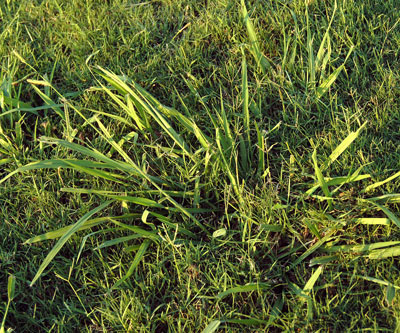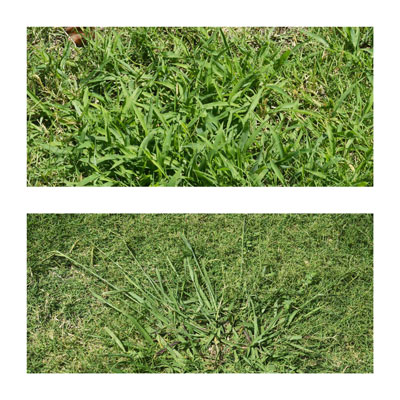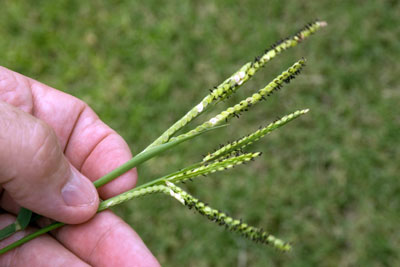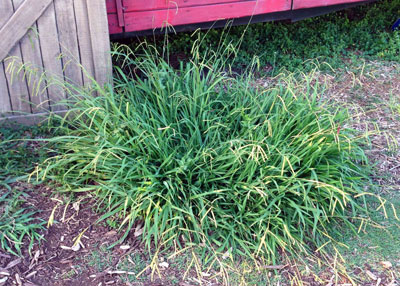Question of the Week #1: June 1, 2017
“Neil, my lawn is being overrun with dallisgrass. What can I do?”

Photo: This is a sight many Texas gardeners are seeing. How can this ugly dallisgrass be eliminated? Click image for larger view.

Photos: Many people mistake dallisgrass (bottom) for crabgrass (top). Dallisgrass is a dark green, clump-forming perennial weed, while crabgrass is a medium-green, annual weed with short runners. Click image for larger view.
Step One in controlling dallisgrass is to identify it. Here are the telltale clues.
• Perennial weed;
• Deep green in summer, brown in winter;
• Forms very dense clumps, extremely short runners or no runners at all;
• Seed heads emerge almost immediately after mowing;
• Seeds are flattened, arranged in rows on heads with black, peppery specks.

Photo: The black specks on dallisgrass seeds are a giveaway to their identity. Click image for larger view.
Step Two is to eliminate new clumps as soon as you see them. Do not allow clumps to flower and go to seed. Once they start casting their seeds, the weed will be spread over large parts of your yard.
Did you know…
… that all dallisgrass seeds are fertile? They do not require pollination. It’s a process called “apomixis.” That adds to the problem in getting rid of the weed if you have an established population of flowering, seeding clumps.

Photo: Can you imagine how many seeds this one mature clump of dallisgrass has spewed out! If only someone had dug and removed it a year or two earlier. Click image for larger view.
Step Three involves eliminating individual clumps, and it’s a tip someone posted on my Facebook page. I’ve been recommending it ever since. Cut the bottom out of a milk carton. Take the top off and discard it and the bottom into the recycle bin. Using a tank sprayer and a glyphosate-only herbicide, push the carton down over a clump of dallisgrass. Insert the nozzle and spray the weed, then move on to the next clump. Or, of course, you can dig and remove them by hand (and foot) with a sharpshooter spade.
Step Four would be for very heavily infested areas. You may want to spray the entire area with a glyphosate-only weedkiller. Give it 10 to 15 days to kill all the vegetation. In fact, watch another couple of weeks to be sure nothing greens back up, and spot-treat if it does. If you are reasonably sure that you got rid of it all, rototill to a depth of 3 or 4 inches and rake out all the rubble, then plant new seed or sod. Honestly, there is a risk that there would be dallisgrass seeds waiting in the soil to germinate, so you may have more plants on your hands later in the season. If that happens, be prepared to dig them by hand immediately.
Good luck on this journey. And special prayers to those of you who have neighbors who have dallisgrass throughout their yards – and who don’t seem to care. Without MSMA available to us any longer, we’re likely to be overrun by this weed. I think I said that earlier.
